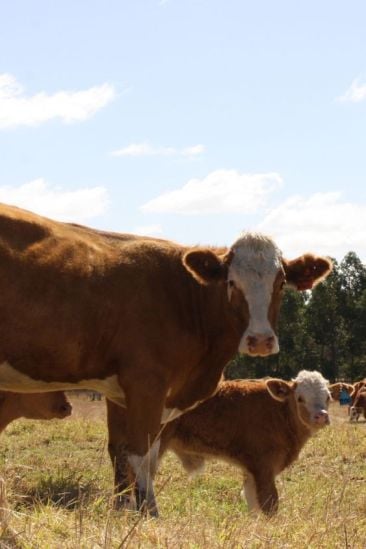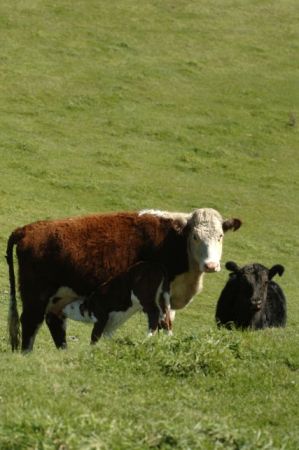Gentically Selecting for Beef With More Meat
Key actions
- Set the breeding objectives for your enterprise.
- Assess the merits of within-breed selection, changing breeds or crossbreeding
- Use BreedObject™ or a similar procedure to develop an index, or refer to breed societies' market-based indexes.
- Select bulls or semen based on an appropriate $Index.
- Bring genetically unrelated bulls into the herd to avoid inbreeding.
- Review your breeding program and tailor it to your requirements, considering traits that are individually important to your program.
- Ensure your breeding program matches your production system and the market being supplied.
Why is genetic improvement important?
Genetics sets the potential for upper or lower production limits that animals can achieve. This can impact on the goals for your beef enterprise, including your market options. Important beef enterprise profit drivers related to animal performance – including weaning rate, cow survival rate, cow weight, calving ease, sale weight, retail beef yield, P8 fat depth and marbling score – are influenced by the genetic make-up of the herd. Using the best cattle genetics allows you to improve the animals' contribution to enterprise profit.
Use best cattle genetics to boost profitability
Although animal genetics cannot improve non-animal production factors, such as pasture and grazing management, it can complement aspects of enterprise management, for example through greater capacity for more efficient feed utilisation and growth rate. Genetics can also determine whether you can achieve a particular production target, like a higher level of marbling or a particular muscle score.
In other situations, genetics can change the way you manage the herd (eg reduced need for supervision at calving) and reduce operational costs (eg easier management resulting from selection for better temperament).
Genetic improvement is about producing the best genotypes of cattle to suit a specific beef enterprises, and genetic gain is cumulative, permanent and relatively cheap.
What is genetic improvement?
Genetic improvement is the use of genetically superior animals as parents of the next generation. The definition of genetic superiority will be a function of many variables, including the production environment and the market being supplied. Most measures of genetic superiority will be based on potential profitability of the genotype for the given production environment and market being supplied. Not all genetic superiority needs to be based on profit but in commercial cattle enterprises, profitability is likely to be most important.
Genetic improvement should be continuous, and the most important variable that will limit continuous improvement is inbreeding. A sustainable genetic improvement program must manage inbreeding.
Other important considerations
A genetic improvement program must be designed in conjunction with culling decisions that influence the current herd and the existing herd management, and with consideration of markets being supplied.

How does this module assist you?
This module assumes that you have made the tactical decision to run a commercial breeding herd. Therefore, you need to select a bull to breed calves. Given that decision, this module will help you buy a bull that is value for money because it improves the genetics that are related to profit in your herd. If you are still undecided about running a commercial breeding herd, then you need to look at Module 1: Setting directions.
This module will assist the discerning commercial breeder whose main avenue for ongoing genetic improvement is through buying-in bulls or semen. It is not specifically designed for seedstock or stud breeders but the principles of setting a breeding objective are still the same. It takes you through the steps of establishing the breeding program to achieve animal production targets that contribute to enterprise profit. It also considers the implications of changing breeds or crossbreeding, and provides a guide to selecting the best bulls for your enterprise and setting up a mating program.
Linkages to other modules
The target markets and proposed herd structure for the beef enterprise are identified in Module 1: Setting directions, in relation to the pattern of pasture growth, long-term market prices, availability of finance and owner/manager goals and constraints. Module 1 also provides guidelines for determining the current performance of the herd. There is a clear linkage to Module 7: Meeting market specifications and Module 5: Weaner throughput.
Principles of cattle genetics
- Some traits of cattle are under genetic control (heritable) and can be exploited to increase herd profitability. Traits that are economically important and are heritable should be included in the breeding objective of beef herds.
- Variation for economically important traits occurs within breeds and between breeds, and some variation can be created by crossbreeds. All sources of genetic variation should be considered when planning a breeding program.
- Bulls have a major influence on commercial breeding programs because of the number of calves they sire. Selection of sires is a critical control point in the operation of an effective breeding program.
- Genetic improvement should be considered in conjunction with non-genetic means of improving performance (eg current herd selection, improved nutrition or changes to market procedures), which may be more cost-effective.
Procedures for using best cattle genetics
- Procedure 1 – Use BreedObject
- Procedure 2 – Select breed
- Procedure 3 – Buy the right bulls
- Procedure 4 – Trait emphasis
- Procedure 5 – Culling policies
fredericksonsurries.blogspot.com
Source: https://mbfp.mla.com.au/cattle-genetics/


0 Response to "Gentically Selecting for Beef With More Meat"
Enregistrer un commentaire